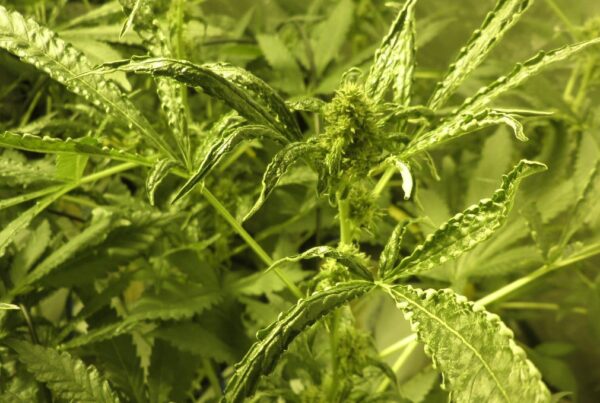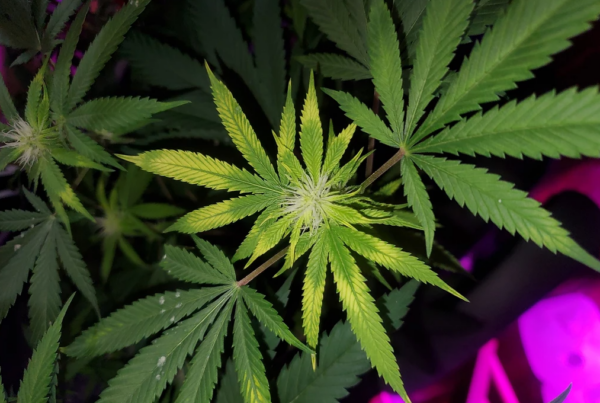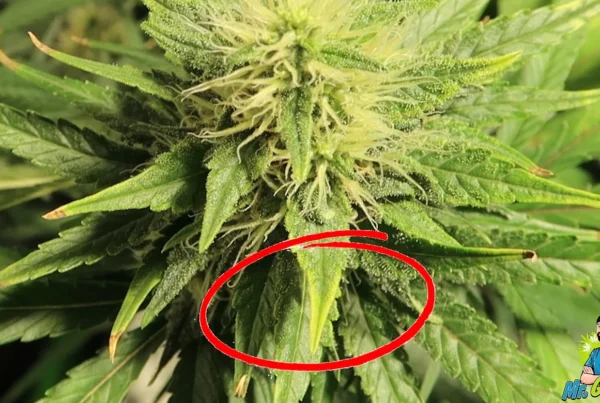As a cannabis gardener, you can run into many different problems during your grow. Most of these problems are easy to identify and treat but some are tricky when it comes to early diagnosis. Root rot is one of the issues that is difficult to pinpoint right away, mainly because roots are underground in the medium. But don’t panic, this article will help you detect and prevent root rot in your cannabis plants which will help you get to a successful harvest.
What is Root Rot?
Before you dig deep into the symptoms and prevention, it is crucial that you understand what root rot is. Root rot is a condition that, as the name implies, affects the root system of the cannabis plant. It is essentially a set of diseases that can cause the roots to rot. Mainly fungi like Phytophthora and Pythium cause root rot but bacteria and nematodes can also inflict it.
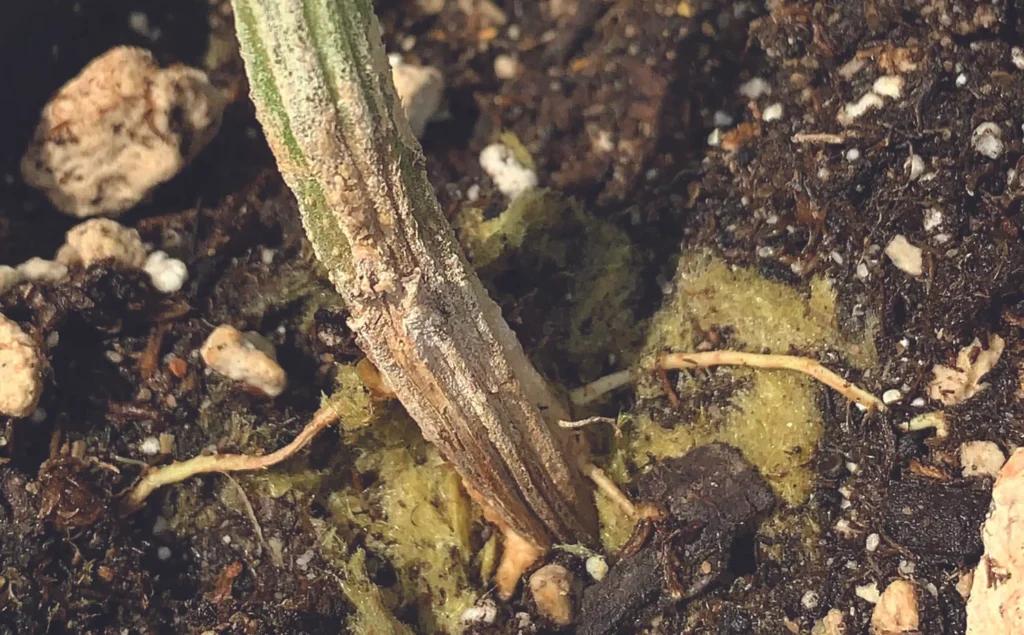
The prevalent cause of root rot is fungi as the spores can inhabit in the soil for a long period and flourish even in hostile conditions. But root rot can affect hydroponics plants equally.
Causes of Root Rot in Cannabis Plants
Although different micro-organisms can inflict root rot, the causes are the same when it comes to this ailment. One of the major causes of root rot is the root system sitting in stagnant water – which may be caused by poor drainage or over-watering. This still water is favorable for the growth of the pathogens that negatively affect cannabis plants’ roots. In a hydroponic system, root rot is mostly caused by too high of water temperature, lack of oxygen in the root zone, and even light leaks. Letting any organic matter decay in the reservoir can also be a contributing factor to root rot. In summary, the following can cause root rot:
- Poor Drainage or Damp Soil
- Over-watering
- High Water Temperature
- Lack of Aeration
- Light Leak
- Decomposing Organic Matter in Reservoir
You should also beware of pests like fungus gnats that can lead to fungus spores dwelling in the soil.
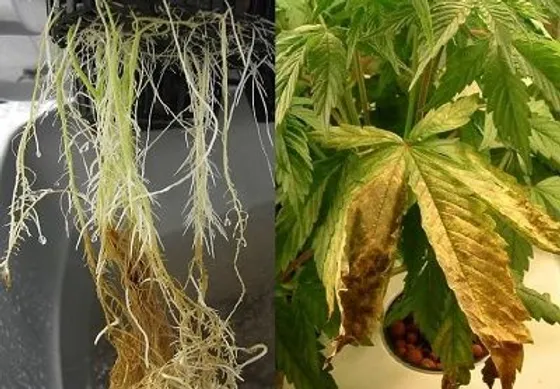
Symptoms of Root Rot in Cannabis Plants
Root rot can be identified by various symptoms. This particular problem gives rise to other problems as well such as nutrient deficiency. Therefore, if you start seeing nutrient deficiency symptoms, it may be a signal that your plant is suffering from root rot. Below is a list of symptoms that can be caused by root rot:
- Slimy and brown roots that are sticking together results from root rot. With healthy roots, you can see individual strands of roots but root rot causes them to stick together. This mushy knot of the root also smells bad. Remember that healthy roots are cream-colored.
- If root rot occurs, leaves look droopy; The plant develops all kinds of nutrient deficiencies that make the leaves curl and turn brown or yellow.
- Rapidly falling and necrotic leaves.
- Plants abruptly showing signs of multiple nutrient deficiencies is an indication of root rot as the plant is unable to absorb nutrients from the growing medium.
- Another strong indication is the plant being in an over-watered medium that takes an abnormal time to dry out. This happens because the plant is incapable of absorbing the amount of water it usually does.
- If Rhizoctania is causing the problem then you may also notice stem ulcers or brown patches on the stems.
There is a chance that these symptoms appear abruptly or the plant may even wilt overnight. If you discover your plant has root rot, it can recover with the right treatment and you can also take measures to ensure that the problem does not happen again.
Root Rot Treatment and Prevention
Some growers believe that discarding or tossing the affected plant is the only thing you can do in the case of root rot as there is no way to save the plant. But that is not true. If the plant has not wilted or died, you may still be able to save it. You can put your plant on the path to recovery with a two-step process. First, you need to treat the roots directly. Secondly, you need to prevent the root rot from happening again. Affected parts of the plant like the slimy roots and brown leaves will not recover but you will see positive changes in the new growth.
Here are the steps that you can take to treat and prevent root rot:
- Good Bacteria: Add good bacteria in the water to strengthen the plant to combat root rot. They also help the plant absorb the nutrients that it needs. Try purchasing a formula that contains the bacteria called Bacillus amlyloliquefaciens. This bacteria can also survive in the water and thus, this formula is good for both soil and soil-less mediums.
- Plenty of Oxygen: As we spoke about before, a lack of oxygen is a big cause of root rot. Increasing oxygen supply in your hydroponic system will help combat the problem. The rule of thumb is that the more bubbles there are, the better it is for the plant. Install air pumps and air stones to get oxygen dissolved in water. Fungus like Pythium cannot flourish in properly aerated water.
- Repair Light Leaks: Light leaks cause root rot in the hydroponic medium since the pathogen causing the issue likes the heat they get from these light leaks. The main rule is to keep lights away from the roots. Make sure your reservoir is pitch black and no light is entering the containers. You can use light-proof tubing, light-proof net pots, and even thick towels to make it dark in the reservoir; take all of the measures you can take in order to prevent the problem.
- Lower the Water Temperature: Water temperature also plays a great role in keeping the plant healthy. Keep the reservoir temperature under 75°F/23°C to help eliminate an environment for bad bacteria to thrive.
- Keep the Space Clean: Keep your grow room and reservoir clean. Remove any organic decomposing matter from your reservoirs immediately. Be consistent in changing the water and add root supplements in the system to make the system strong against any pathogens and diseases.
With these steps, you will see new and white roots growing – but old roots will not recover. Also, remember to stay consistent with the above best practices and do not give up; you can save your plant from this pesky problem by putting in a bit of work.
![]()






